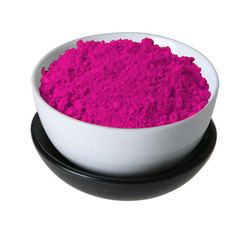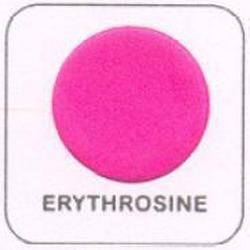Formula C20H6I4Na2O5 Classification Fluoresceins | Molar mass 879.86 g/mol | |
 | ||
Erythrosine, also known as Red No. 3, is an organoiodine compound, specifically a derivative of fluorone. It is cherry-pink synthetic, primarily used for food coloring. It is the disodium salt of 2,4,5,7-tetraiodofluorescein. Its maximum absorbance is at 530 nm in an aqueous solution, and it is subject to photodegradation.
Contents

Uses
It is used as a:

Erythrosine is commonly used in sweets such as some candies and popsicles, and even more widely used in cake-decorating gels. It is also used to color pistachio shells. As a food additive, it has the E number E127.
Health effects

As a result of efforts begun in the 1970s, in 1990 the U.S. FDA had instituted a partial ban on erythrosine, citing research that high doses have been found to cause cancer in rats. In June 2008, the Center for Science in the Public Interest (CSPI) petitioned the FDA for a complete ban on erythrosine in the United States.

A series of toxicology tests combined with a review of other reported studies concluded that erythrosine is non-genotoxic and the above-mentioned increase in tumors is caused by a non-genotoxic mechanism.

A 1990 study concluded that "chronic erythrosine ingestion may promote thyroid tumor formation in rats via chronic stimulation of the thyroid by TSH."
Regulation and prevalence

While commonly used in many countries of the world, erythrosine is less commonly used in the United States (the second least used after Fast Green FCF) because Allura Red AC (Red #40) is generally used instead. However, Allura Red AC is banned in many European countries because it is an azo dye. Erythrosine can be used in colored food and ingested drugs in the USA without any restriction, however, its use is banned in cosmetics and external drugs. The lake variant is also banned from use in the United States.
Synonyms
Erythrosine B; Erythrosin B; Acid Red 51; C.I. 45430; FD & C Red No.3; E127; 2',4',5',7'-Tetraiodo-3',6'-dihydroxy-spiro[3H-isobenzofuran-1,9'-xanthen]-3-one disodium salt; Tetraiodofluorescein Sodium Salt; Calcoid Erythrosine N; 2,4,5,7-Tetraiodo-3,6-dihydroxyxanthene-9-spiro-1'-3H-isobenzofuran-3'-one disodium salt; 2',4',5',7'-Tetraiodofluorescein, disodium salt; C.I.Food Red 14; Aizen Erythrosine; Tetraiodifluorescein, disodium salt; Spiro[isobenzofuran- 1(3H),9'-[9H]xanthen]-3-one, 3',6'-dihydroxy-2',4',5',7'-tetraiodo-, disodium salt.
Classification
It is listed under the following number systems:
